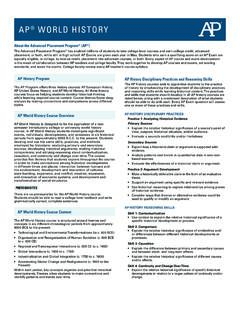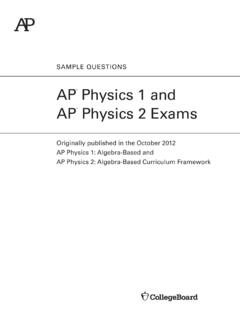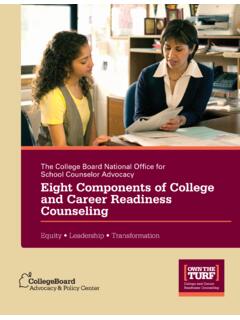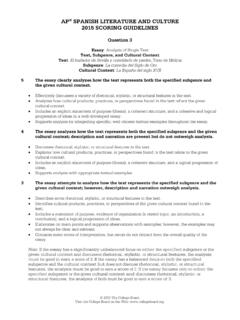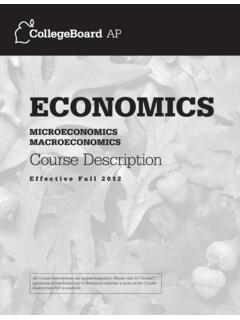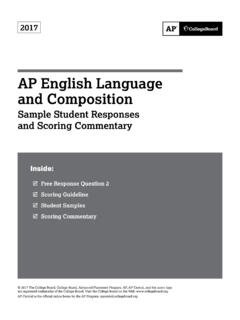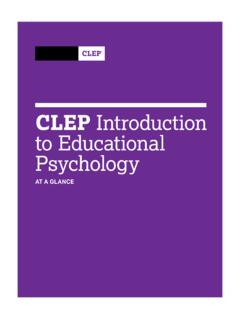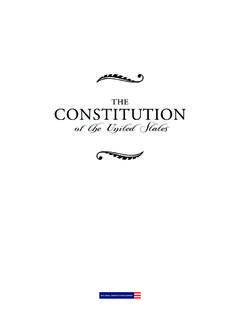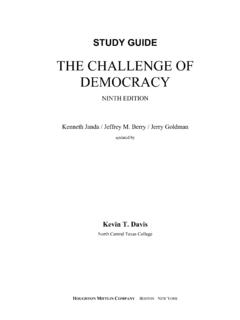Transcription of AP Comparative Government and Politics Democratization ...
1 AP Comparative Government and Politics DemocratizationBriefing Paper G. Bingham Powell, Jr. University of RochesterRochester, New York Eleanor N. PowellHarvard UniversityCambridge, Massachusetts connect to college success Briefing Paper ii Copyright 2005 by College Board. All rights reserved. Available at The College Board: Connecting Students to College Success The College Board is a not-for-profit membership association whose mission is to connect students to college success and opportunity. Founded in 1900, the association is composed of more than 4,700 schools, colleges, universities, and other educational organizations. Each year, the College Board serves over three and a half million students and their parents, 23,000 high schools, and 3,500 colleges through major programs and services in college admissions, guidance, assessment, financial aid, enrollment, and teaching and learning. Among its best-known programs are the SAT , the PSAT/NMSQT , and the Advanced Placement Program (AP ).
2 The College Board is committed to the principles of excellence and equity, and that commitment is embodied in all of its programs, services, activities, and concerns. Permission to Reprint Statement The College Board intends this publication for noncommercial use by teachers for course and exam preparation; permission for any other use must be sought from the College Board. Teachers may reproduce this publication, in whole or in part, in limited print quantities for noncommercial, face-to-face teaching purposes and distribute up to 50 print copies from a teacher to a class of middle or high school students, with each student receiving no more than one copy. This permission does not apply to any third-party copyrights contained within this publication. When educators reproduce this publication for noncommercial, face-to-face teaching purposes, the following source line must be included: Democratization Briefing Paper. Copyright 2005 by College Board. Reprinted with permission.
3 All rights reserved. This material may not be mass distributed, electronically or otherwise. This publication and any copies made from it may not be resold. No party may share this copyrighted material electronically by fax, Web site, CD-ROM, disk, e-mail, electronic discussion group, or any other electronic means not stated here. In some cases such as online courses or online workshops the College Board may grant permission for electronic dissemination of its copyrighted materials. All intended uses not defined within noncommercial, face-to-face teaching purposes (including distribution exceeding 50 copies) must be reviewed and approved; in these cases, a license agreement must be received and signed by the requestor and copyright owners prior to the use of copyrighted material. Depending on the nature of the request, a licensing fee may be applied. Please use the required form accessible online. The form may be found at: Briefing Paper iii Copyright 2005 by College Board.
4 All rights reserved. Available at Equity Policy Statement The College Board and the Advanced Placement Program encourage teachers, AP Coordinators, and school administrators to make equitable access a guiding principle for their AP programs. The College Board is committed to the principle that all students deserve an opportunity to participate in rigorous and academically challenging courses and programs. All students who are willing to accept the challenge of a rigorous academic curriculum should be considered for admission to AP courses. The Board encourages the elimination of barriers that restrict access to AP courses for students from ethnic, racial, and socioeconomic groups that have been traditionally underrepresented in the AP Program. Schools should make every effort to ensure that their AP classes reflect the diversity of their student population. For more information about equity and access in principle and practice, please send an email to Copyright 2005 by College Board.
5 All rights reserved. College Board, AP Central, APCD, Advanced Placement Program, AP, AP Vertical Teams, Pre-AP, SAT, and the acorn logo are registered trademarks of the College Entrance Examination Board. Admitted Class Evaluation Service, CollegeEd, Connect to college success, MyRoad, SAT Professional Development, SAT Readiness Program, and Setting the Cornerstones are trademarks owned by the College Entrance Examination Board. PSAT/NMSQT is a trademark of the College Entrance Examination Board and National Merit Scholarship Corporation. Other products and services may be trademarks of their respective owners. Visit College Board on the Web: For further information, visit Democratization Briefing Paper 1 Copyright 2005 by College Board. All rights reserved. Available at Democratization : A Briefing Paper for AP Comparative Government and Politics G. Bingham Powell, Jr., and Eleanor N. Powell The introduction of democratic regimes in many countries that were previously ruled by military governments, one-party states, and personal dictatorships has been one of the most dramatic political trends of the last 30 years.
6 By a democratic regime, we mean a set of institutions that allow the citizens to choose the makers of public policy in free, competitive elections. For such elections to be free and competitive implies that prospective voters enjoy fair choices between contending candidates and political parties. In addition, all adults in the country must be eligible and able to vote regardless of race, gender, poverty, ethnicity, or other discriminating characteristic. Countries with free and fair elections for the real policymakers and eligibility of all adults meet the minimum requirements for a procedural democracy. It is important to be aware that the presence of elections, even elections allowing several parties to run candidates, is not sufficient to qualify a country as a democracy. In some countries, the military council, dominant party, or strong-man ruler makes the real decisions behind the scenes, with an elected legislature as a facade. In other countries, the opposition parties are so disadvantaged in what they can say, or how freely they can organize, or how fairly their votes are counted that they have no real chance.
7 Their organizers and supporters may be threatened or murdered. Although sometimes such countries are called by such names as guarded democracy or illiberal democracy, we consider them forms of electoral authoritarianism, not democracies at Democratization Briefing Paper 2 Copyright 2005 by College Board. All rights reserved. Available at In addition to the requisite free and fair competitive elections of a procedural democracy, many more political rights and civil liberties are necessary for a country to be deemed a substantive democracy. Freedom of the press, freedom of organization, independence of the courts, and equal treatment of minorities are just a few examples of the qualities that may be minimally present in a procedural democracy, but whose fuller realization is vital to a substantive democracy. In a substantive democracy, citizens have access to multiple sources of information. They can use political and civil rights to enable themselves to learn about Politics and to try to influence the choices of others.
8 They can form interest groups, trade unions, and political parties. Citizens are generally free from abuses of their personal integrity through repressive governmental threats, political murders, and disappearances, imprisonment, or torture for nonviolent political activity. Corruption is sufficiently controlled that the elected officials can meaningfully carry out public policies that the citizens desire. Sometimes we refer to achievements of substantive democracy as a deepening of democracy or an improvement in its democratic No nation has perfectly achieved all the elements of substantive democracy, but some have progressed much further than others. All substantive democracies are, by definition, also procedural democracies, but the reverse is not necessarily true. The presence of a procedural democracy is a necessary but not sufficient condition for the development of substantive democracy. Democratization , then, refers to the transformation process from a nondemocratic regime to a procedural democracy to a substantive democracy, either as the first Government in a newly independent country or by replacing an Democratization Briefing Paper 3 Copyright 2005 by College Board.
9 All rights reserved. Available at authoritarian system in an older one. It is important to note that a country may stagnate or stop altogether at some intermediate step in the Democratization process and that the transformation to a substantive democracy may take years, decades, or never be completed. Historically, only a handful of countries had introduced institutions of democracy before 1900. But the twentieth century saw what Samuel Huntington has called three waves of The first of these waves had its origins in the late nineteenth century. It grew slowly under demands from increasingly educated and urbanized citizens. By the late 1920s, there were over 20 democracies among about 65 independent nations of the world, using very loose, procedural definitions. A number of these democracies collapsed, especially under the economic turmoil of the Great Depression of the early 1930s, or were overrun by aggressive Nazi Germany. The proportion of democracies declined, partially reversing the first wave.
10 The victory of the Allies in World War II and the breakup of the European colonial empires in Africa, Asia, and the Caribbean introduced a second wave of newly democratic states. Some older democracies deepened the quality of their democratic institutions by extending full civil and political rights to women and minorities. However, a number of the new democracies failed soon after their introduction, while the 1960s and 1970s saw the overthrow of others, reversing the second wave. Then, the late 1970s saw the beginning of a third wave of Democratization , which started in Southern Europe, spread through Latin America and Asia, and accelerated with the collapse of the Soviet Union s control of Eastern Europe in Democratization Briefing Paper 4 Copyright 2005 by College Board. All rights reserved. Available at 1989. In 1991 the Soviet Union itself broke up into new states, many of which began as democracies. Electoral competition replaced various forms of authoritarian rule in many African states in the early 1990s.
